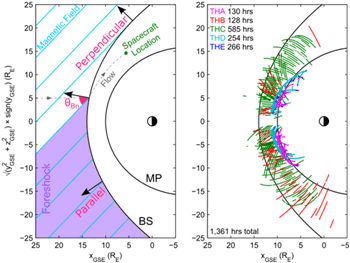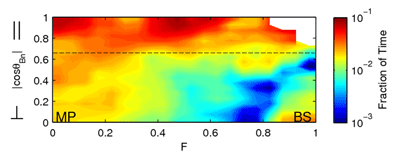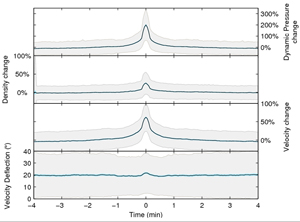
2013 THEMIS SCIENCE NUGGETS
Magnetosheath dynamic pressure enhancements: Occurrence and typical properties
by Martin Archer, Space and Atmospheric Physics Group
The Blackett Laboratory, Imperial College London
Introduction
The size of the magnetosphere, Earth’s magnetic bubble in space, is given in a steady state by a balance of pressure similar to that in a piston (see Figure 1). At the boundary of the bubble, known as the magnetopause (MP), the magnetic pressure inside counteracts the solar wind’s dynamic pressure (given by the product of the solar wind density and the velocity squared).
| Figure 1. Cartoon of the piston-like pressure balance at the magnetopause. |
However, the real interface between the solar wind and this boundary is the magnetosheath. This is a region behind the bow shock (BS) where the solar wind has been slowed, heated and deflected (see Figure 2). The pressure in this region can sometimes contain abrupt pulses which were not present in the solar wind. Whilst these have been observed previously, these studies have only involved a small number of events or days at a time and until now the origin and properties of these pulses have been unclear. However, using multiple THEMIS spacecraft we have determined their typical properties and the factors which control their occurrence in the first comprehensive statistical study into such pulses.
| Figure 2. Cartoon demonstrating the angle θBn , highlighting parallel and perpendicular geometries. The foreshock region is ahead of the more parallel shock. (right) Positions of the THEMIS spacecraft in the magnetosheath between June-September 2008 used in this study. The average bow shock (BS) and magnetopause (MP) locations are also shown. |
Results
The times that the five THEMIS spacecraft were in the magnetosheath during the 2008 dayside science phase of the mission were found and combined with solar wind data as well a mathematical model of the magnetosheath (see Figure 2). This enabled the investigation of where and under what conditions pressure pulses occur.
Overall it was found that pulses in the dynamic pressure of greater than 100% the background value occur about 2% of the time. One of the key parameters controlling the nature of the magnetosheath is the geometry of the bow shock, given by the angle between the normal to the shock surface and the solar wind magnetic field, known as θBn (see Figure 2 left). We have calculated the fraction of the time that pulses are observed as function of this geometry along with the depth in the magnetosheath (see Figure 3). The pulses are most frequent behind almost parallel shocks and are observed at all depths throughout the magnetosheath. Therefore, the pulses originate at the bow shock and travel through the magnetosheath. It was also found that the solar wind magnetic field was generally more steady than usual during periods of pulses, which suggests that a stable foreshock (see Figure 2 left) is important in their generation. Under more perpendicular geometries pulses occur mostly near the magnetopause and are therefore not generated around the shock: they are likely associated with the boundary.
| Figure 3. Fraction of the time that >100% dynamic pressure pulses are observed in the magnetosheath as a function of the depth and bow shock geometry. ‖ and ⊥ indicate the parallel and perpendicular cases. |
Pulses of up to 15 times the background dynamic pressure were identified in the study. Their typical properties were determined by taking the average over all events. Figure 4 shows the resulting dynamic pressure pulse from this analysis of approximately 30 second duration. The enhanced dynamic pressure was dominated by an increase in the flow velocity with only a small increase in plasma density. This velocity, however, was generally only deflected by a few degrees more than the plasma around it. The plasma in the pulses is typically colder than its surroundings, though the thermal pressure shows small increases, and the magnetic field strength is slightly reduced. The total pressure, and thus the pressure acting upon the magnetopause, is increased due to these pulses.
| Figure 4. Average times series of identified events showing the percentage changes in the dynamic pressure, density and velocity as well as the velocity deflection. Black lines show the mean while the blue and grey regions are the corresponding 95% confidence intervals and standard deviations. |
Conclusion
We have presented the first comprehensive statistical study into large, abrupt pulses in the magnetosheath dynamic pressure, which do not originate in the solar wind. They occur about 2% of the time and can have amplitudes up to 15 times the background. These pulses are dominated by velocity increases with generally only a small increase in the density, though the velocity is not typically highly deflected. They are predominantly found behind almost parallel shock geometries, at all depths and under fairly steady solar wind magnetic fields. This suggests that the foreshock is key to their generation. Since the pressure on the magnetopause is increased by these pulses, they have the potential to trigger vibrations/waves of Earth’s magnetic field and are therefore important.
Reference
Archer, M. O., and T. S. Horbury (2013), Magnetosheath dynamic pressure enhancements: Occurrence and typical properties, Ann. Geophys., 31, 319–331, doi:10.5194/angeo-31-319-2013.Biographical Note
Martin Archer is a PhD student in the Space & Atmospheric Physics group at Imperial College London. For more, visit http://www.martinarcher.co.uk
 Please send comments/suggestions to
Emmanuel Masongsong / emasongsong @ igpp.ucla.edu
Please send comments/suggestions to
Emmanuel Masongsong / emasongsong @ igpp.ucla.edu




